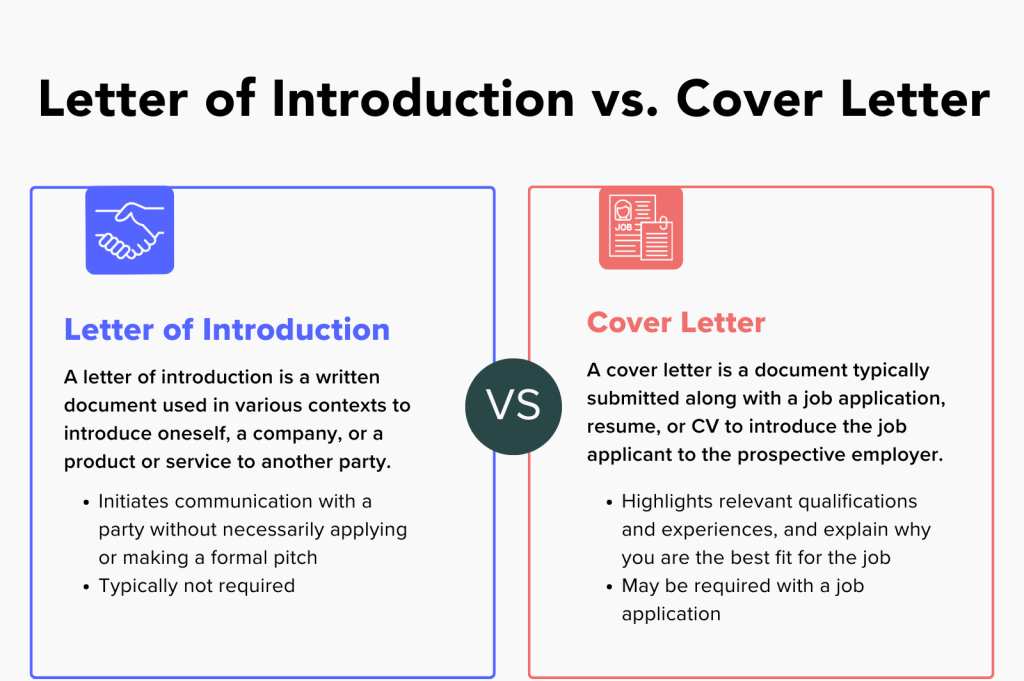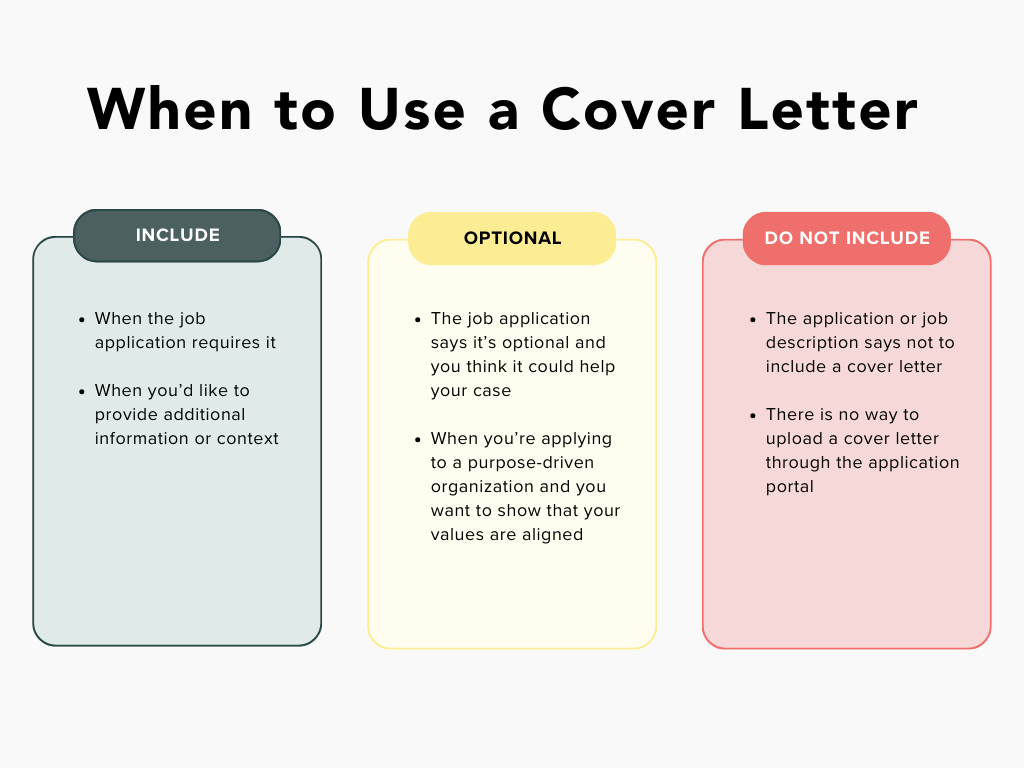When job searching, you may find yourself needing to send a letter of introduction or a cover letter to a potential employer. While they might appear similar at first glance, these two types of letters serve distinct purposes in the realms of networking, job applications, and career development.
Here’s what you need to know about them.
Letter of introduction vs. cover letter
A letter of introduction is a written document used in various contexts to introduce oneself, a company, or a product or service to another party.
Today, most “letters” of introduction are actually emails of introduction. Their primary purpose is to initiate communication without necessarily applying for a specific job or making a formal pitch.
A cover letter, on the other hand, is a document typically submitted along with a job application, resume, or CV.
While not every job application will require one, cover letters certainly aren’t dead yet and are often still an essential part of landing an interview.
The goal of a cover letter is to introduce the job applicant to the prospective employer. Within it, you may highlight relevant qualifications and experiences, and explain why you are the best fit for the job.

When to use a letter of introduction
Formal letters of introduction aren’t as common as they once were, but there are several situations where you may find yourself writing one. Here are some common scenarios where a letters of introduction may be used:
- Networking: People often use letters of introduction when reaching out to new contacts or potential mentors in their professional network. It serves as a way to introduce yourself, highlight relevant skills or experiences, and express the desire to connect for mutual benefit.
- Job search: While not as common as traditional cover letters, some job seekers use a letter of introduction to express their interest in a company or inquire about potential job opportunities. These letters aim to establish a connection and generate interest before submitting a formal job application.
- Business: Companies may use this document to introduce their services or products to potential clients or partners. These letters provide a brief overview of the company’s offerings and the value it can bring to the recipient’s business.
- Sales and marketing: Sales professionals may send letters of introduction as part of their outreach strategy to warm up potential leads. These letters can pique the recipient’s interest and lay the groundwork for future discussions.
A well-crafted letter of introduction should be concise, engaging, and tailored to the specific context and audience. It should provide enough information to spark interest and prompt further communication. While it may not include a detailed job application or a sales pitch, it should convey enthusiasm and professionalism to make a good first impression.
When to use a cover letter
A cover letter can be a valuable addition to your job application, but it’s important to know when it’s most appropriate to include one.
Here are some scenarios where you should use a cover letter:
- When the job description requires it: If the job posting explicitly asks for a cover letter, don’t skip it.
- When you’d like to provide additional information or context: Sometimes, your resume might not fully capture your qualifications or experiences. A cover letter gives you space to elaborate on specific points, share anecdotes, or explain career transitions or career gaps. It can provide valuable context that a resume alone cannot.
While not always mandatory, there are situations where submitting a cover letter can work to your advantage:
- When it’s optional and you think it could help your case: Some job applications offer the option to include a cover letter, even if it’s not required. If you have the time and believe that a well-crafted cover letter can enhance your application, consider taking this opportunity to stand out.
- When you’re applying to a purpose-driven organization: Purpose-driven organizations often have specific values and goals. In these cases, submitting a cover letter can be an excellent opportunity to align your personal values with the organization’s mission. It allows you to convey your passion and commitment beyond what your resume may show.
If a job posting says not to submit one or there isn’t a way to submit one, don’t do it.

What’s in a letter of introduction?
While the specific content can vary depending on the context and purpose of the letter, a well-structured letter of introduction typically includes the following elements:
- Greeting: Begin your letter with a polite and professional salutation.
- Introduction: In the opening paragraph, introduce yourself briefly. State your name, job title (if applicable), and provide a concise overview of your background, expertise, or the nature of your business.
- Purpose: Clearly state the purpose of the letter. Explain why you are reaching out and what you hope to achieve through this introduction. Whether it’s to establish a professional connection, explore potential collaboration, or express interest in a job, be transparent about your intentions.
- Relevance and benefits: In the body of the letter, elaborate on why the recipient should be interested in you. Highlight relevant qualifications, skills, achievements, or offerings that align with the recipient’s needs or interests. Make a compelling case for why the recipient should pay attention to your introduction. Explain the value and potential benefits of the connection or collaboration you are proposing
- Call to action: Conclude the letter with a clear call to action. Specify the next steps you’d like the recipient to take, whether it’s scheduling a meeting, discussing potential opportunities, or simply acknowledging receipt of the letter.
- Contact info: Provide your contact information, including your phone number and email address. This makes it easy for the recipient to get in touch with you.
Remember that the content and tone of a letter of introduction can vary based on the specific context and audience. Whether you’re introducing yourself to potential employer or networking contact, personalizing your letter is essential for making a good impression.
What’s in a cover letter?
Cover letters are an essential component of the job application process and serve several important functions:
- Introduction: Your cover letter intro should be an attention-grabber that makes the recruiter want to learn more.
- Showcasing qualifications: Cover letters allow you to elaborate on their qualifications, skills, and experiences mentioned in your resume. It provides an opportunity to explain how your background aligns with the job requirements.
- Customization: Tailor the cover letter to the specific job application. This demonstrates that you have done your research on the position and can articulate why you are a good fit.
- Demonstrating enthusiasm: Cover letters often convey the applicant’s enthusiasm for the job and the company. This enthusiasm can be a compelling factor in the hiring process, as it shows the applicant’s genuine interest.
- Addressing potential concerns: If there are gaps in the applicant’s employment history, a career change, or other elements of their background that may raise questions, use a cover letter to address these issues and provide context.
- Request for action: Cover letters typically conclude with a call to action, such as requesting an interview or expressing the applicant’s readiness to discuss their qualifications further.
While the format and content of a cover letter can vary, it should generally be clear, concise, and well-organized.
The bottom line
Understanding the distinct roles of a letter of introduction and a cover letter is crucial in the professional landscape. Each serves a specific purpose. If you’re applying for a job, you’ll want to use a cover letter. If you’re reaching out to connect or inquire about available opportunities, a letter of introduction will be the go-to. Recognizing when to use each and mastering the art of crafting them can boost your job search and networking efforts.
